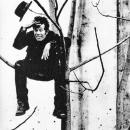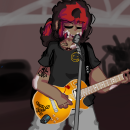#12 No hombre, no me malinterpretes. He tomado con muy buena nota tu aporte. Pero mi pregunta es, al ajustar tu Les Paul como dices a 1,5mm en 6ª cuerda y 1mm en 1ª, las cuerdas 3ª y 4ª te quedan por encima de 1,2mm ??? Si lo ajusto a esa altura, a mi se me quedan a 1mm pelao y me trastean.
Altura de cuerdas (acción) en vuestras guitarras

OFERTAS Ver todas
-
-29%Boss T-Shirt CCB-DS1TSC (Talla S)
-
-7%BOSS RE-202 Space Echo
-
-17%PRS SE CE 24 BR

#13
Sí, es un tema de pura geometría. Si las cuerdas asentadas sobre las selletas dibujan la misma curvatura del mástil, y la cejuela también, la altura en toda las cuerdas sobre un mismo traste han de diminuir de manera progresiva, pero nunca una cuerda 3 o 4 quedan por debajo de la 2 y la 1. Si no dibuja el mismo radio, o bien el puente no tiene la curvatura correta, o bien son los surcos de las selletas los que no están bien, o es la cejuela.
Si te pasa eso, es que o bien el puente/selletas o bien la cejuela tienen un radio más grande del que tiene el diapasón.
Sí, es un tema de pura geometría. Si las cuerdas asentadas sobre las selletas dibujan la misma curvatura del mástil, y la cejuela también, la altura en toda las cuerdas sobre un mismo traste han de diminuir de manera progresiva, pero nunca una cuerda 3 o 4 quedan por debajo de la 2 y la 1. Si no dibuja el mismo radio, o bien el puente no tiene la curvatura correta, o bien son los surcos de las selletas los que no están bien, o es la cejuela.
Si te pasa eso, es que o bien el puente/selletas o bien la cejuela tienen un radio más grande del que tiene el diapasón.
 Baneado
Baneado
Hay un toque que se usa en guitarra con el pulgar generalmente para las cuerdas entorchadas graves y le dicen Apoyando, donde se ataca la cuerda presionándola hacia abajo bien profundamente (nunca tirando hacia arriba jamás) y luego ese pulgar descansa sobre la cuerda contigua inferior.
Ese tipo de ataque o toque permite que con poca fuerza se consiga la máxima sonoridad y volumen, que con poca fuerza y un simple movimiento se logre el mayor impacto para que la cuerda pueda resonar libremente.
Si utilizamos una guitarra con las cuerdas pegadas al diapasón, creo que seria imposible utilizarla para esta técnica sin que trastee, y en todo caso....acá esta el punto a donde iba, TODA GUITARRA TIENE UN MAXIMO NIVEL DE TOLERANCIA A LA FUERZA DE PULSACIÓN. Esto quiere decir, que por mas que tengamos las cuerdas altas y el mango totalmente cóncavo y sea la mejor guitarra, siempre vamos a encontrar ese punto limite de resistencia donde vamos a encontrar el trasteo a menos que toquemos mas suave. Y no hablo de tocar como bestias para ver hasta donde trastea la guitarra. Pero todas en algún punto, y dependiendo de la técnica del guitarrista, vana encontrar ese limite y habrá trasteo.
Ahora, si la idea es tocar como mantequilla, con guitarras de mantequilla, eso es otra cosa, pero ahí se demuestra que podemos acostumbrarnos a tocar suave sin encontrar ese punto máximo de tolerancia del instrumento.
Ese tipo de ataque o toque permite que con poca fuerza se consiga la máxima sonoridad y volumen, que con poca fuerza y un simple movimiento se logre el mayor impacto para que la cuerda pueda resonar libremente.
Si utilizamos una guitarra con las cuerdas pegadas al diapasón, creo que seria imposible utilizarla para esta técnica sin que trastee, y en todo caso....acá esta el punto a donde iba, TODA GUITARRA TIENE UN MAXIMO NIVEL DE TOLERANCIA A LA FUERZA DE PULSACIÓN. Esto quiere decir, que por mas que tengamos las cuerdas altas y el mango totalmente cóncavo y sea la mejor guitarra, siempre vamos a encontrar ese punto limite de resistencia donde vamos a encontrar el trasteo a menos que toquemos mas suave. Y no hablo de tocar como bestias para ver hasta donde trastea la guitarra. Pero todas en algún punto, y dependiendo de la técnica del guitarrista, vana encontrar ese limite y habrá trasteo.
Ahora, si la idea es tocar como mantequilla, con guitarras de mantequilla, eso es otra cosa, pero ahí se demuestra que podemos acostumbrarnos a tocar suave sin encontrar ese punto máximo de tolerancia del instrumento.



#17 El fabricante, Gibson en este caso, en su web de ajuste recomienda 6/64 y 4/64 pulgadas, que en milimetros es 2,4 y 1,6. Esto si que me parece alto.
2mm en 6ª cuerda no me parece alto, pero repito que cuando con el resto de mis guitarras toco como mucho a 1,6mm pues lo noto raro. Pero claro que es una altura razonable con la que se puede tocar perfectamente.
2mm en 6ª cuerda no me parece alto, pero repito que cuando con el resto de mis guitarras toco como mucho a 1,6mm pues lo noto raro. Pero claro que es una altura razonable con la que se puede tocar perfectamente.

Por si vale de algo...
Hi I'm David the final inspector at Gibson Memphis. I can give you the factory spec info. on our setups. You will need a mechanics rule to do this properly.
To check neck relief: fret the low E at the first and 15th fret (not 12th) reach to the 7th fret and tap string. There should be a small space between string and fret - no thicker than a piece of paper. Do the same with the high E. ACTION: fret low E at first fret and measure the distance from the bottom of the to the top of the 15th fret. It should be 5/64". Do the same with the high E, measurement should be 3/64". Now measure the string height at the nut; underside of the string to the top of the fret. Low E and A should measure 2/64", D and G =1.5/64" and B and high E = 1/64". If string height at nut is correct, recheck string height at 12th fret with strings open. Measurement for low and high E's should be the same as measurement taken at the 15th.
Pickups: Fret low E at 22nd fret and measure pickup height from underside of string to point on pickup closest to string. Bridge pickup should be 3/64" (I think the 3/64" is a typo, it should be 3/32") , neck pickup should be 4/32". Fret high E at 22nd fret, distance for both pickups should be 3/32".
Play test: Play every string at every fret checking for buzzes. Bend High E string 1 and 1/2 steps, beginning at the sixth fret and ending at 22nd, checking for "choking" and to make sure string stays in nut notch.
Hi I'm David the final inspector at Gibson Memphis. I can give you the factory spec info. on our setups. You will need a mechanics rule to do this properly.
To check neck relief: fret the low E at the first and 15th fret (not 12th) reach to the 7th fret and tap string. There should be a small space between string and fret - no thicker than a piece of paper. Do the same with the high E. ACTION: fret low E at first fret and measure the distance from the bottom of the to the top of the 15th fret. It should be 5/64". Do the same with the high E, measurement should be 3/64". Now measure the string height at the nut; underside of the string to the top of the fret. Low E and A should measure 2/64", D and G =1.5/64" and B and high E = 1/64". If string height at nut is correct, recheck string height at 12th fret with strings open. Measurement for low and high E's should be the same as measurement taken at the 15th.
Pickups: Fret low E at 22nd fret and measure pickup height from underside of string to point on pickup closest to string. Bridge pickup should be 3/64" (I think the 3/64" is a typo, it should be 3/32") , neck pickup should be 4/32". Fret high E at 22nd fret, distance for both pickups should be 3/32".
Play test: Play every string at every fret checking for buzzes. Bend High E string 1 and 1/2 steps, beginning at the sixth fret and ending at 22nd, checking for "choking" and to make sure string stays in nut notch.




Prueba una cosa, toma las medidas en otro traste como referencia
Y ajustas la acción con el truqui este de la tarjeta
https://www.youtube.com/watch?v=tnVuvoj3WXs&t=34s
Y vuelves a medir a ver. Es más para otro tipo de puente, pero te puede servir igual para ver hasta dónde puedes bajar sin trasteo y no te tienes que dejar los ojos mirando milímetros
Y ajustas la acción con el truqui este de la tarjeta
https://www.youtube.com/watch?v=tnVuvoj3WXs&t=34s
Y vuelves a medir a ver. Es más para otro tipo de puente, pero te puede servir igual para ver hasta dónde puedes bajar sin trasteo y no te tienes que dejar los ojos mirando milímetros
Hilos similares
Nuevo post
Regístrate o identifícate para poder postear en este hilo

